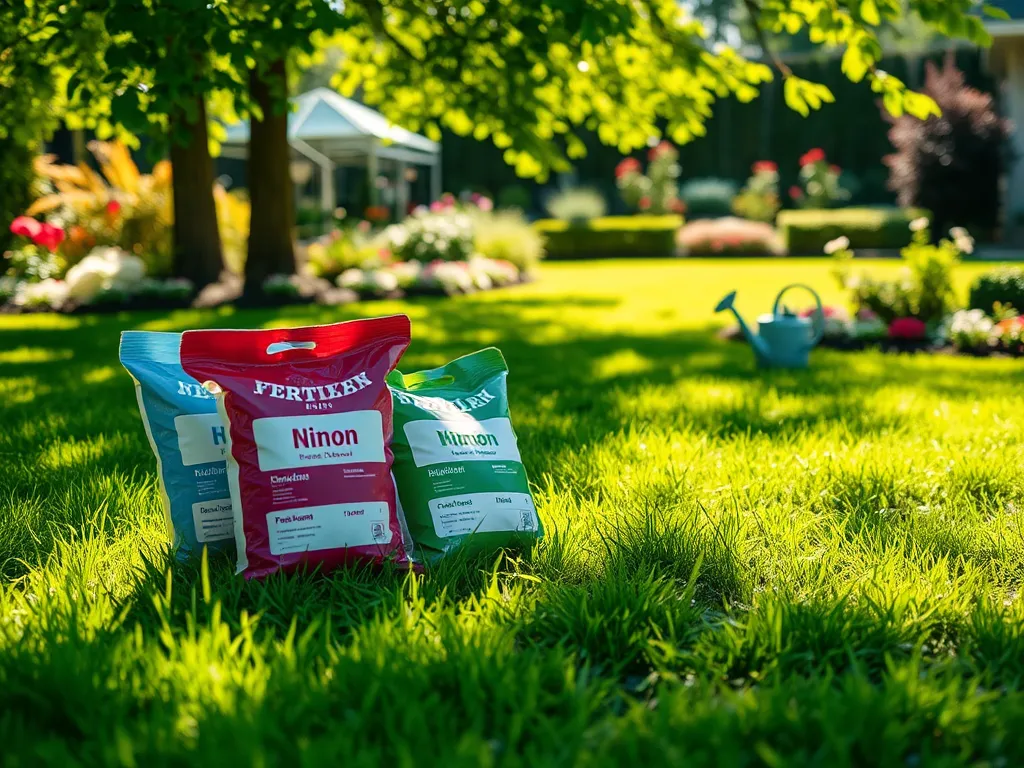Choosing the Best Synthetic Fertilizer for Your Lawn

Choosing the Right Synthetic Fertilizer for Your Lawn
Choosing the Right Synthetic Fertilizer for Your Lawn is crucial for maintaining a lush, healthy, and vibrant lawn. While grass is known for its resilience, it often requires supplemental nutrients to thrive, particularly in areas with poor soil quality or extreme weather conditions. Understanding the specific needs of your lawn, the types of fertilizers available, and how to apply them effectively will ensure that you make informed decisions that lead to optimal growth and health for your grass.
Choosing the Right Synthetic Fertilizer for Your Lawn involves several nuances, starting with a solid grasp of your lawn's nutritional needs. Grass requires a balance of macronutrients—nitrogen, phosphorus, and potassium—and micronutrients such as iron and magnesium, which aid in various metabolic processes. Conducting a soil test can reveal nutrient deficiencies and help you select a fertilizer that compensates for what your lawn lacks, paving the way for robust growth and green color.
In addition to understanding nutritional needs, it’s important to consider the types of synthetic fertilizers available on the market. They can generally be categorized into granular and liquid forms, each with its pros and cons. Granular fertilizers are slower to release nutrients and can provide a more sustained feeding, while liquid fertilizers deliver nutrients quickly and can be more easily absorbed by the grass. Knowing the right type for your lawn situation can make a significant difference in performance and results.
A solid foundation for a thriving garden begins with NPK ratio understanding, as it determines nutrient balance.
Application techniques are also a pivotal aspect of Choosing the Right Synthetic Fertilizer for Your Lawn. Proper timing and spreading techniques can determine whether your effort will yield fruitful outcomes or lead to issues like burning or uneven growth. Ideally, fertilizers should be applied during the growing season when grass is actively taking up nutrients, and using equipment like spreaders can ensure even distribution across your lawn, preventing over-application in certain areas.
Selecting the right grass type fertilizers is crucial for achieving a lush and vibrant lawn all year round.
Finally, when making your choice, it’s essential to be conscious of the environmental impact of synthetic fertilizers. Over-fertilizing can lead to runoff, which may pollute local water sources and affect ecosystems. Exploring sustainable practices, such as using slow-release fertilizers and incorporating organic matter into your lawn care routine, can mitigate these negative effects and help maintain a healthy balance for both your lawn and the environment.
Opting for soil test-based selection helps tailor your gardening approach to the specific needs of your soil.
Understanding Lawn Nutritional Needs
Essential nutrients for healthy grass include nitrogen (N), phosphorus (P), and potassium (K)—often referred to as the primary macronutrients. Nitrogen is vital for leaf growth and green color; phosphorus aids in root development and flowering, while potassium enhances drought resistance and overall plant health. Additionally, micronutrients like calcium, magnesium, and iron, though needed in smaller quantities, are equally important for sustaining lawn health and vigor.
Signs of nutrient deficiency in lawns include yellowing leaves, stunted growth, and excessive weed proliferation. For instance, if the grass appears pale green or yellow, it may indicate a nitrogen deficiency. Stunted root growth can suggest a lack of phosphorus, while browning tips and visibly weak grass may point to potassium shortages. Identifying these symptoms can guide you in choosing the right synthetic fertilizer to restore your lawn's health.
Balancing macronutrients and micronutrients is crucial for a healthy lawn. Ideally, your chosen fertilizer should cater to the specific nutrient deficiencies identified in your soil test, ensuring that the grass receives an adequate mix. Avoiding an over-reliance on one nutrient can prevent imbalances that lead to poor lawn health and growth. Therefore, a comprehensive understanding of your lawn's nutrient requirements is key to effective fertilization.
Types of Synthetic Fertilizers
Granular vs. liquid synthetic fertilizers are two main categories to consider when choosing the right product for your lawn. Granular fertilizers are often easier to apply and can provide a slow, consistent release of nutrients. Conversely, liquid fertilizers can act quickly and may be absorbed more readily by grass, making them ideal for quick fixes or during periods of intense growth. Knowing your lawn's specific needs will help determine which type is more suitable for your situation.
Controlled-release vs. quick-release options present another differentiation within synthetic fertilizers. Controlled-release fertilizers are designed to release nutrients gradually over time, ensuring that your grass receives a steady supply without the risk of nutrient leaching. Quick-release fertilizers, on the other hand, provide immediate nutrition but may require more frequent applications to sustain growth. Balancing these options according to your lawn's growth patterns can yield better results.
Organic vs. synthetic fertilizers is another important consideration. While organic fertilizers are derived from natural sources and contribute to soil health in the long run, they generally release nutrients at a slower rate. Synthetic fertilizers, while delivering nutrients quickly, may result in short-term gains but can potentially lead to environmental concerns. Understanding the pros and cons of each type will aid in making an informed decision based on the desired outcomes for your lawn.
Application Techniques for Synthetic Fertilizers
Best times to apply fertilizer for lawns depend largely on the type of grass you have and the climate in your region. Generally, late spring or early summer is considered the optimal time for fertilization, as this aligns with the grass's active growth phase. It is advisable to avoid fertilizing during drought conditions or extreme heat, as this can stress your lawn and lead to poor nutrient absorption.
How to properly spread fertilizer on your lawn is another essential area to master for effective application. When applying granular fertilizer, it’s best to use a spreader to ensure an even distribution across your lawn. For liquid fertilizers, using a sprayer can help cover large areas without saturation in specific spots. Proper technique prevents burning the grass and creates an evenly nourished lawn.
Using equipment for even fertilizer distribution is critical for maximizing efficacy. Hand-held spreaders, drop spreaders, or broadcast spreaders can all offer varying degrees of precision in fertilizer application. For larger lawns, a tractor-mounted spreader may be beneficial. Ensuring that your equipment is calibrated to the correct settings will lead to uniform distribution and effective nutrient uptake by your lawn.
Environmental Impact of Synthetic Fertilizers
Potential runoff and water pollution issues posed by synthetic fertilizers are significant environmental concerns. When used excessively, synthetic fertilizers can wash away during rainstorms, entering local water systems and causing algal blooms that affect aquatic ecosystems. Understanding the appropriate amounts and timing for application can greatly mitigate this issue, ensuring responsible lawn care practices.
Sustainable practices in lawn care can help counterbalance the impact of synthetic fertilizers. Implementing methods such as incorporating compost into your lawn, practicing integrated pest management, and planting cover crops can enhance soil health and reduce the need for synthetic inputs over time. These practices promote a healthier lawn environment while minimizing adverse effects on local ecosystems.
Alternatives to synthetic fertilizers should also be explored to foster a more environmentally friendly approach to lawn care. Organic fertilizers made from animal waste or plant materials can improve soil structure while providing essential nutrients. Biostimulants, foliar feeds, and other natural amendments can also enhance lawn health without the challenges presented by synthetic options.
Effects of Synthetic Fertilizers on Lawn Health
How synthetic fertilizers influence grass growth is well-documented. Their immediate availability of nutrients can lead to rapid growth and a lush, green appearance. However, it's essential to apply them correctly to avoid nutrient leaching and burning of the grass, which can counteract the benefits of fertilization. Monitoring your lawn's growth response to synthetic fertilizers over time can help determine the best practices for your unique situation.
Common lawn problems caused by over-fertilization include excessive growth, which may regular mowing and maintenance, as well as increased susceptibility to pests and diseases. Over-fertilized grass might develop a shallow root system, making it more vulnerable during drought conditions. Understanding the fine line between adequate nutrition and over-application is key to sustainable lawn care.
Improving lawn resilience through proper fertilization can lead to healthier grass capable of withstanding environmental stresses such as drought, pests, and diseases. By adhering to recommended application guidelines and focusing on balanced nutrient delivery, you can cultivate a lawn that not only appears lush and green but also thrives in the face of challenges.
